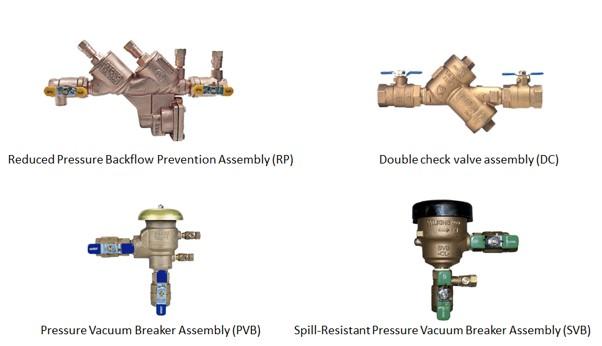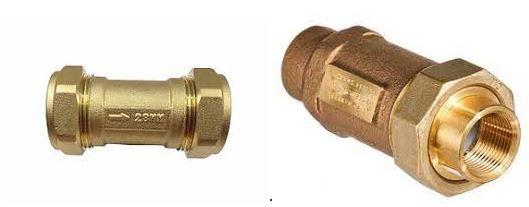Business
Backflow prevention
What is Backflow prevention?
How do you prevent Backflow occurring?
Backflow Prevention Device registration
BackFlowID – upgrading to a new simplified system
What is Backflow prevention?
Backflow prevention is the term used to describe stopping an unwanted reverse flow of water from a potentially polluted source entering the drinking water supply.
Backflow occurs when a condition exists in a water supply system that will cause back-siphonage or back-pressure. Back-siphonage can occur on a property through a vacuum created in the water supply system.
An example of back-siphonage would be a pipeline breakage, undersized pipework or high withdrawal rates. Back-pressure can occur within properties when high pressure is generated downstream by pumps, thermal expansion or elevation.
Backflow prevention starts within a property boundary, by isolating a potential source of contamination from the town mains or storage tanks (rainwater tanks) from the tap or appliance.
Properties requiring backflow prevention may include:
- Motels and unit complexes
- Hotels
- Vehicle/machinery repair workshops
- Shops
- Restaurants
- Caravan parks
- Medical and dental surgeries
- Car and plant washing facilities
- Dry cleaners and laundries
- Hospitals and funeral parlours
- Club houses for sports
- Schools
- Day care centres and kindergartens
- Pest control and water carrying vehicles
- Botanic gardens
- Industrial sites
- Properties with alternate water supplies.
Examples of potential sources of contamination include:
- Fire hose reels
- Irrigation
- Swimming pools with top up
- Vehicle maintenance pits
- Ornamental ponds
- Cooling towers
- Vehicle/bin washing bays
- Chemical storage areas
- Recycled water systems
- Commercial dish washer with chemical injection
- Combi ovens
- Interceptor traps/oil separators.
Property owners have a responsibility to provide and maintain backflow prevention devices to protect other water consumers from the activities on your property.
How do you prevent Backflow occurring?
A suitable backflow prevention device (one-way valve) will eliminate any risk of contamination of the drinking water supply. Backflow devices are either testable or non-testable types with the selection dependent on the risk of possible contamination.
Figure 1: Examples of testable Backflow Prevention Devices

Figure 2: Examples of non-testable Backflow Prevention Devices
Discuss options with your plumber to determine whether a non-testable device may be suitable for your situation. This option in most cases is only applicable to residential properties i.e. rainwater tanks. If a non-testable device is suitable for your situation, you will not need to register the device with Council.
Backflow Prevention Device registration
Council is required, in accordance with Section 101 of the Plumbing and Drainage Regulation 2019, to maintain a program for the registration, maintenance and testing of testable backflow prevention devices.
Backflow Prevention Devices must be installed, tested and serviced by a person who is licenced to carry out this type of work. Each testable backflow prevention device installed in the Gladstone Regional Council area must be registered with Council.
Registration process
- For new work approved by Council through a Plumbing and Drainage Compliance Permit, registration will occur as part of this approval process once the related Form 9 is received by Council.
- For testable backflow prevention devices added to an existing building, it is the responsibility of the licensed plumbing contractor to submit the related Form 4 to the Queensland Building and Construction Commission (QBCC) and forward a copy of the completed Form 9 to Council. The device will then be added to Council’s Backflow Register.
- For removing/replacing a device It is the responsibility of the licensed plumbing contractor to submit the related Form 4 to the Queensland Building and Construction Commission (QBCC) and forward a copy of the completed Form 9 to Council. The device will then be removed from/added as a replacement to Council’s Backflow Register.
- For existing devices not captured, registration will occur based on the Form 9 received from the endorsed backflow plumber.
Annual testing requirements
All testable backflow prevention devices are to be tested annually. The property owner is required to ensure backflow prevention device/s are kept in good working order and the annual test is carried out by a backflow endorsed licensed plumber. It is the tester’s responsibility to provide a copy of the test report (Form 9) to the property owner and the local government within 10 business days of carrying out the testing of a device.
Failure to conduct backflow testing could pose a risk to public health, as devices prevent the reverse flow of water from a potentially polluted or contaminated source into drinking and bathing water supply systems. Penalties apply for non-compliance.
Renewals
There is an annual renewal fee for all testable backflow prevention devices. The renewal period runs from 1 July to 30 June the following year. The renewal notices are issued to the property owner of a premise containing a backflow device/s. This fee can be viewed in our Fees & Charges.
Funds from the annual registration fee per device are used to maintain Council's Backflow Prevention Program, which involves managing the register, performing audits, investigations and for any correspondence that may need to be sent to property owners.
Reminder notices are also issued to the property owner when annual renewal fees are not paid by the due date.
BackFlowID – upgrading to a new simplified system
We're upgrading to a new simplified system for backflow prevention device registration and compliance – BackFlowID (powered by QR2id.com). This system will be rolled out across the region soon.
What is BackFlowID?
BackFlowID is an interactive asset tag from BPAA Inc. The secure BackFlowID tag simplifies the requirements for registering each testable backflow prevention device. The cloud-based BackFlowID register is integrated with Council’s own data bases and IT systems.
How does BackFlowID work?
A licensed tester simply uses their smart phone to scan the BackFlowID tag. The device and other details are automatically loaded, so the applicable test results can be entered. The tester’s GPS location is checked against that of the device and a Form 9 is automatically generated.
Key benefits:
- Simplified system
- Real-time data
- Interactive platform for customer, Council and plumber
- Ability for plumbers to set automatic scheduling of annual testing
- Automatic test results (Form 9) to owner, Council and plumber.
How do I get a BackFlowID tag?
The BackFlowID tag will be attached to your device/s by your plumber during your next annual test at no cost to you. The tag is free and the annual licensing fee will not increase.
Please note: Initial tags for existing devices will only be attached during testing. Be sure to ask your plumber to attach the BackFlowID tag at the time of testing.
Do I need to do anything?
- Mention the BackFlowID tag available from Council to your plumber when scheduling your annual backflow device testing.
- Remind the plumber to attach the BackFlowID tag to your device/s at the time of testing.
Gladstone Regional Council
Connect. Innovate. Diversify.
Get in Touch
Phone
(07) 4970 0700
Opening Hours
8.30am - 5pm Monday to Friday
Social media
Postal Address
PO Box 29, Gladstone Qld 4680
Council Offices
101 Goondoon Street, Gladstone Qld 4680
3 Don Cameron Drive, Calliope Qld 4680
41 Blomfield Street, Miriam Vale Qld 4677
Cnr Wyndham & Hayes Avenues, Boyne Island Qld 4680
Rural Transaction Centres
71 Springs Road, Agnes Water Qld 4677
47 Raglan Street, Mount Larcom Qld 4695
Footer Acknowledgement
Gladstone Regional Council would like to acknowledge the Bailai, the Gurang, the Gooreng Gooreng and the Taribelang Bunda people who are the traditional custodians of this land. Gladstone Regional Council would also like to pay respect to Elders both past, present and emerging, and extend that respect to other Aboriginal and Torres Strait Islander people. Learn more about Council's Reconciliation Action Plan (RAP).
Chat Popup
All content © Gladstone Regional Council. All Rights Reserved.
Back to the top








